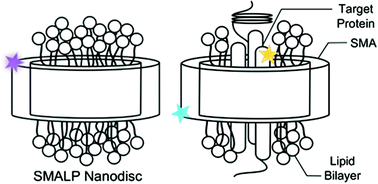Fluorescent styrene maleic acid copolymers to facilitate membrane protein studies in lipid nanodiscs†
Abstract
Fluorescently-labelled variants of poly(styrene-co-maleic acid), SMA, have been synthesised by RAFT copolymerisation. We show that low ratios of vinyl fluorophores, analogous to styrene, can be successfully incorporated during polymerisation without detriment to nanodisc formation upon interaction with lipids. These novel copolymers are capable of encapuslating lipids and the model membrane protein, gramicidin, and hence have the potential to be applied in fluorescence-based biological studies. To demonstrate this, energy transfer is used to probe polymer–protein interactions in nanodiscs. The copolymers may also be used to monitor nanodisc self assembly by exploiting aggregation-caused-quenching (ACQ).



 Please wait while we load your content...
Please wait while we load your content...